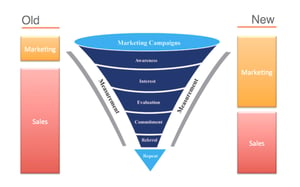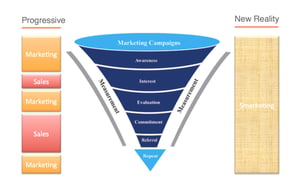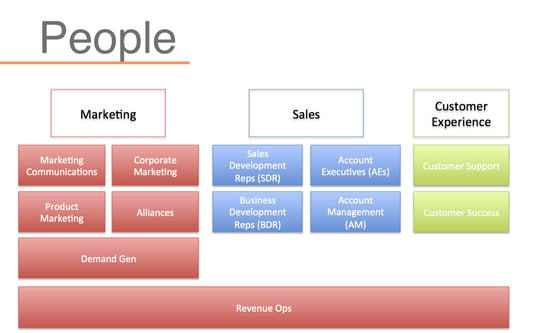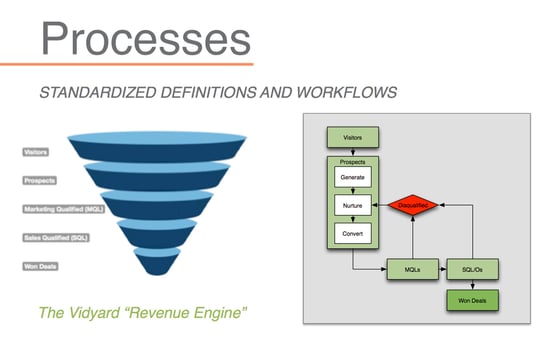This is part of a series of interviews with B2B revenue leaders. This interview is with Joe Gelata, Director of Business Operating System at Clearpath.
Note: at the time of the interview, Joe was working at Vidyard as the Head of Global Demand Generation.
Who are you and what do you do?
My name is Joe Gelata. I’m the head of global demand generation and revenue operations at Vidyard. On the demand gen side, that means we’re all about creating demand in our prospect base, converting them, and sending them over as marketing qualified leads. On the revenue operations side we have more of a full-funnel focus, all about optimising the funnel, making sure it’s operating properly, and keeping the systems in line right across the whole funnel – no silos.
That leads into our first question. Revenue Operations is a relatively recent title, what does it look like it practice?
It’s a lot of project management and analysis. Our goal is to identify where gaps are in our funnel or our processes. It’s a lot of analysis and data tracking to try to find those holes, find solutions to them, and implement those solutions. We work right from marketing to sales, everyone involved with revenue or customers. We try to find out where we can improve things, where the gaps are, and implementing the solutions for those gaps.
So you’re bridging the gap between Sales and Marketing?
Exactly. Making sure they’re perfectly aligned. Even beyond Sales, when people go to customer success and making sure all those handoffs are smooth. We want to see everything and have radical transparency across the whole funnel.
That seems to have come out of funnels changing over the last couple of years. What does a modern funnel look like?
We still follow a standard funnel, like the Sirius Decisions funnel, right from awareness through to customer. But I think the challenge people face is that there is no such thing as a linear journey through the funnel. So there are many ways to track how people are moving through it and how to guide them to the next step is the big thing.
For us we track every time someone starts a journey, we follow it, and if they happen to fall-back we start a new journey for them so we don’t overwrite data. We look at the path up and down the funnel to get an idea of how people are moving. It helps us identify where the holes are but also what realistic targets should be for things like time-through-funnel and the actual path they take.
Instead of looking at it as a marketing path from awareness to lead, and a sales path from lead to purchase, you’re treating it as a single pathway?
Exactly. It’s all one thing that everyone hopefully goes through from top-to-bottom. We don’t want to treat it like a linear journey, though.

You and Tyler Lessard, Vidyard's CMO, recently did a talk about this at Communitech, you called it Smarketing. What is that?
Yeah it’s a term that’s been used here since the beginning of Vidyard. We look at Marketing and Sales as one organization called Smarketing. There’s definitely silos in terms of job function, everyone has their own job to do, but we look at it as one team with one common set of goals. It comes down from the top and helps keep us focused on the goals. Demand Gen isn’t focused on MQLs, we’re focused on the amount of revenue we close. And in Marketing when you’re creating content, you’re focused on how that content is going to impact topline revenue. Sales is easier to track because they’re closer to it. But at the end of the day we’re all focused on revenue and growth.
In your talk, Tyler said there are four Ps to make a Smarketing team come together. It’s your people, platforms, process, and programs. Most companies have some of these refined, but they’re still really silo-based. How do you get them to move from silos to a unified marketing team?
It comes from the top and bottom. From an executive level you need to have a strategic view to invest in all those different pieces and give the resources to make things happen. Most organizations do that really well. Where the breakdown occurs is where the rubber meets the road, when people are executing on the projects. They may lose sight of the strategic goal and things start to break down – that’s where the revenue operations team comes in. They sit underneath the whole organization to create the unified method of doing things, and keeps everyone focused on the same goal.
I always use the analogy of an Oreo cookie to describe it. Executive strategy is the top of the cookie, revenue operations is at the bottom, and they both kind of hold together the good stuff in the middle — which is the most important piece and is going to determine if you’re successful.
Does the marketing team change as you’re moving to that model? Do you have different people?
We still have all the traditional people, like content, product marketing, and demand gen, but there’s a bigger focus on the numbers side now. It’s not just creative people creating cool stuff, we’ve got data scientists and growth hackers to analyze what’s happening and proving what’s working or not working in some cases. It’s a much more metrics-driven approach. We’re a startup, so we live and die by growth. If we can’t scale the company we fall on our face. So we put those processes in place to know where our opportunities are so we can take advantage of them.
If you’re an old-school company, who’s the first person you bring in if you have a traditional marketing team?
I think it starts with Demand Gen. They’re maybe less creative than a content team would be, but still creative enough they can run your programs. But they bring numbers. That’s where most people start and it grows from there. So as you get into tracking MQLs and SQLs are converting, then you can really start diving into revenue, your processes, and deeper metrics. That’s when you’re building a revenue operations team and they’re finding opportunities for you every day from the lowest-level stuff you can track.
So when we talk about how sales is a scientific process, this is the science of marketing?
Yes. Sales if fairly easy to track because you look at the numbers and the conversion rates. On the marketing side, it’s very much the same thing but you need to extend it to the top of the funnel. You need to connect what’s happening when you first get a lead to how they close, what they’re doing throughout, and how you can align your marketing to that in your sales process.
What we’re trying to do now is go above the visible funnel. Going out into the social realm and things you can’t necessarily control, and monitoring people for what they’re doing. There’s been tools out there to monitor social conversations but connecting that to the bottom of the funnel is something that hasn’t been possible before. That’s the stage we’re at now, trying to connect that full funnel, everything above it to the bottom.
What platforms do you need to have in place for that? It seems like there’s a new sales and marketing tool every day.
CRM is the first one to start with. You need your sales database housed somewhere.
Marketing automation goes on top of that so you have somewhere to execute campaigns. From there you’re getting more into the analytics and that’s where there’s a lot of opportunity depending on what you’re looking at. Traditionally a lot of those technologies are focused on certain points of the funnel, so they’re generally not good at tying things together across the entire funnel. Looking at a technology like Lift's Revenue Intelligence that can look at the top, look at the bottom, and tie it together into one report, or a suite of reports, that gives you the broad look at everything.
Thanks for the shout-out. Once you understand your process, you have your team in place, you have your tools. Now you’re running programs. Typically people run these out of their automation platform, but they’re aren’t necessarily tied to the funnel. How do you find gaps in your programs and start addressing them?
We always tend to look at, not only the total volume of leads and how they convert downstream, but we look at the conversion rate at each stage of the funnel, the speed at which it converts at each stage—the velocity. We take those three things into account and we split it up every possible way. Like is this content working better in one market segment or another and comparing that to what’s going on at the bottom of the funnel. Like if we’re doing really well in one segment we want to make sure we have all the resources to support that. You kind of weight who you want to target and make sure you have the content to support them and that the content will work to move them through the funnel.
Do you map that back to your buying process? Is it measured how the buyer thinks of the purchase or against your internal sales stages?
We have a couple of different phases of the funnel. The top phase, which identifies interest before they’re a known contact, like the social realm. We can do research but we can’t necessarily connect that to the bottom of the funnel. Although now we’re able to start tracking people on social. Before we never saw those social interactions before people converted to a lead. So that’s the top of the funnel. The big focus there is just on volume, getting people in the door is the main thing.
The second is demand generation, we divide that up into engagement campaigns, bringing people into the funnel, and nurturing campaigns, so once they’re in the funnel we keep them warm with constant education until they’re interested.
Eventually they move into the third piece which is conversion campaigns, when they’re actually ready to do a demo or a trial or something like that. At this point we pass them over to the Sales team. The Sales team goes through several different phases there, they go through pre-qualification with an SDR or a BDR. After that we hand them over to an account executive, that’s when we consider it a qualified opportunity. And it goes through multiple deal stages there until it closes.
Looking at it holistically, if you’re trying to build this—you have revenue operations, you have your people, your processes, but if you’re exec team isn’t bought in it’s not going to work. How do you get them to buy in?
That’s probably the biggest challenge. Revenue operations is something I’ve been trying to do for many years, and this is the first time I’ve actually been able to do it. I think it’s when executives look at it they see it as another cost centre. If they don’t have the vision to see the potential gains they might just blow it off.
Here we’re looking at our inability to track our performance on the marketing side specifically. We didn’t know what to invest in. We were getting a tonne of volume from some campaigns but then no revenue was coming from it, and others we were investing very little in and getting a lot out of it. When we were able to actually see how big that gap was it made sense to start implementing some processes and solutions to track that better. From there the revenue operations team formed. It was a logical next step after being able to prove results and show traction. We can invest better. There are obvious gains to it, so it made sense to look this way across the whole funnel.
So you’re changing the way you look at ROI from “How many leads did marketing create?” to “Did this actually create revenue?”
Yeah, also how much did it take to get there. What was our investment at the top of the funnel? How many resources did it take to get through the funnel?
Like SaaS metrics – lead velocity, CAC?
You got it.
Getting people to think that way is fun.
It’s a big change for a lot of people, but any marketing team thinking that way is reaping the rewards.
Where do people go to learn more if they want to learn about Smarketing or revenue operations?
There’s a couple different places. More on the operations/demand gen side, I have a blog called Revenue Engineer, or you can follow me on Twitter.
Another one is the Vidyard blog.
I like your blog.
It’s a fantastic resource. We’ve got some really powerful writers. Traditionally it’s more focused on video marketing, but because we are so metrics focused it’s not just about creative videos, it’s how you tie it to ROI – how do you tie it from the view to closed deal? What metrics are important? How do you do lead scoring? Stuff like that.



